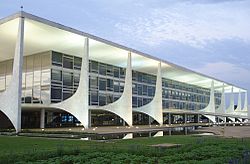
Back Moderne (Architektur) ALS عمارة الحداثة Arabic Movimientu Modernu AST Мадэрнізм (архітэктура) Byelorussian Модернистична архитектура Bulgarian Luskad modern Breton Moderna arhitektura BS Arquitectura moderna Catalan Moderní architektura Czech Pensaernïaeth Fodern Welsh
| Modern architecture | |
|---|---|
Top: Villa Savoye, France, by Le Corbusier (1927); Empire State Building, New York, by Shreve, Lamb & Harmon (1931) Center: Palácio do Planalto, Brasília, by Oscar Niemeyer (1960); Fagus Factory, Germany, by Walter Gropius and Adolf Meyer (1911–1913) Bottom: Fallingwater, Pennsylvania, by Frank Lloyd Wright (1935); Sydney Opera House, Sydney, Australia, by Jørn Utzon (1973) | |
| Years active | 1920s–1980s |
| Location | International |
Modern architecture, also called modernist architecture, or the modern movement, is an architectural movement and style that was prominent in the 20th century, between the earlier Art Deco and later postmodern movements. Modern architecture was based upon new and innovative technologies of construction (particularly the use of glass, steel, and concrete); the principle functionalism (i.e. that form should follow function); an embrace of minimalism; and a rejection of ornament.[1]
According to Le Corbusier, the roots of the movement were to be found in the works of Eugène Viollet-le-Duc,[2] while Mies van der Rohe was heavily inspired by Karl Friedrich Schinkel.[3][4] The movement emerged in the first half of the 20th century and became dominant after World War II until the 1980s, when it was gradually replaced as the principal style for institutional and corporate buildings by postmodern architecture.[5]
- ^ "What is Modern architecture?". Royal Institute of British Architects. Retrieved 15 October 2018.
- ^ Froissart, Rossella (2011). Avant-garde et tradition dans les arts du décor en France. lectures critiques autour de Guillaume Janneau (in French). Marseille: Université de Provence - Aix-Marseille. p. 73.
- ^ "6.12. Karl Friedrich Schinkel and the Bauakademie". 28 June 2020.
- ^ "Mies & Schinkel : Das Vorbild Schinkels im Werk Mies van der Rohes - Deutsche Digitale Bibliothek".
- ^ Tietz 1999, pp. 6–10.





